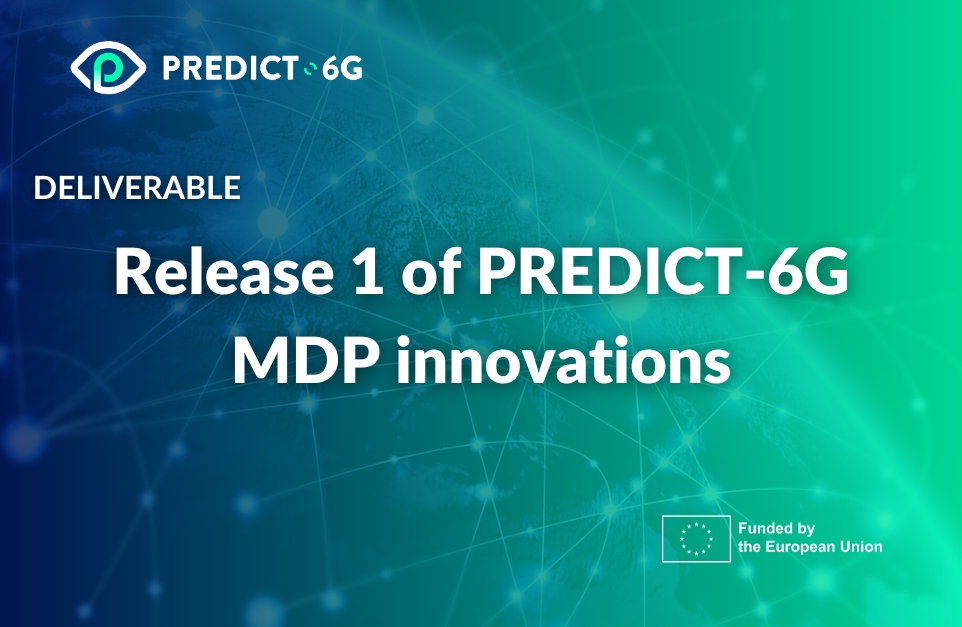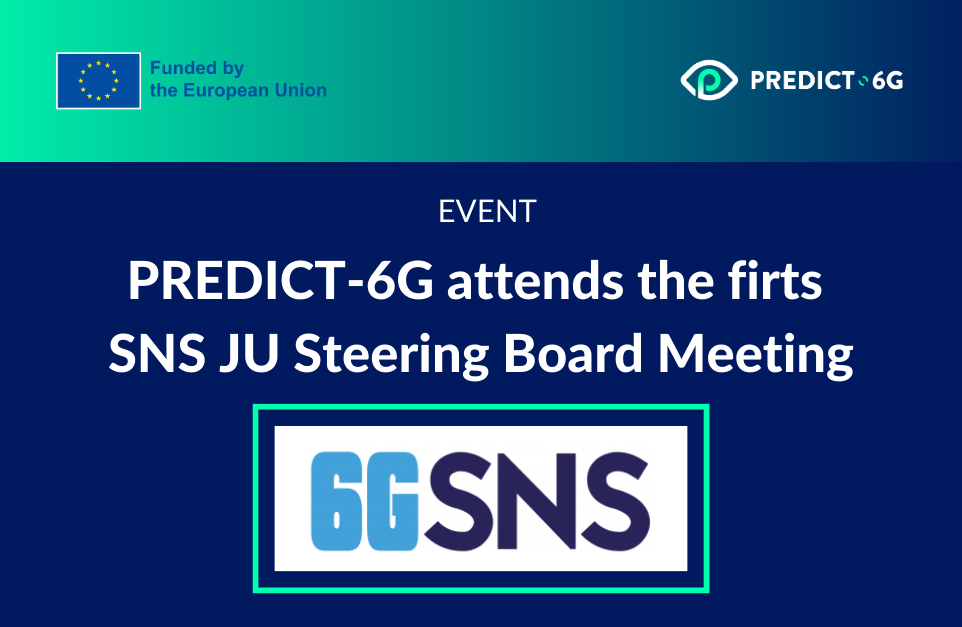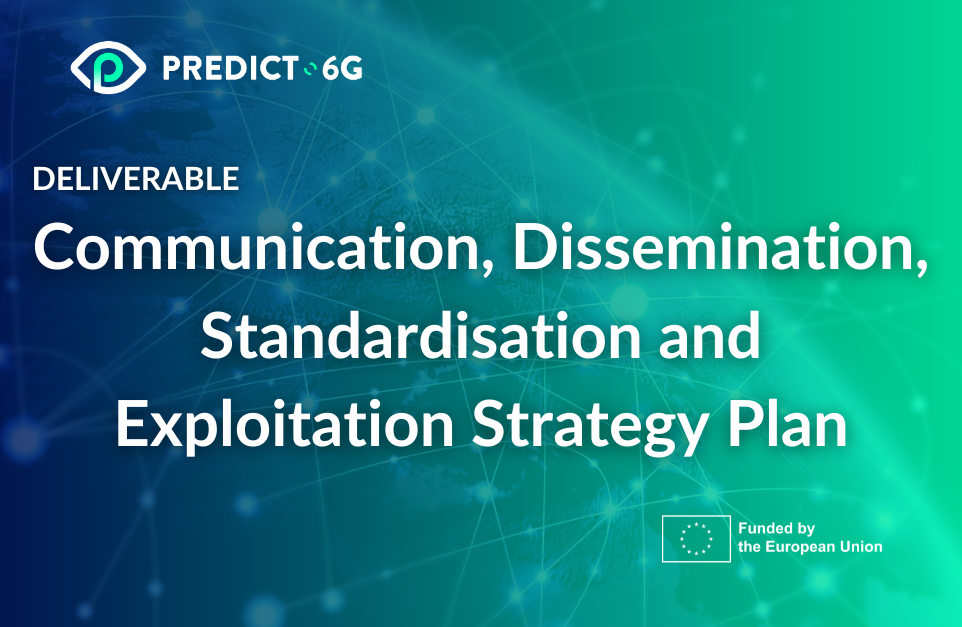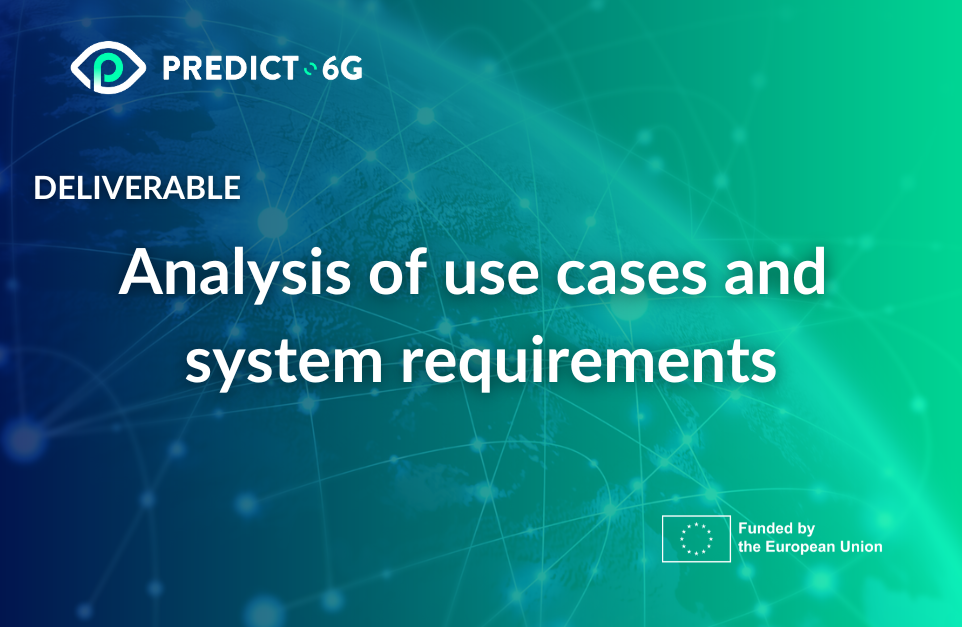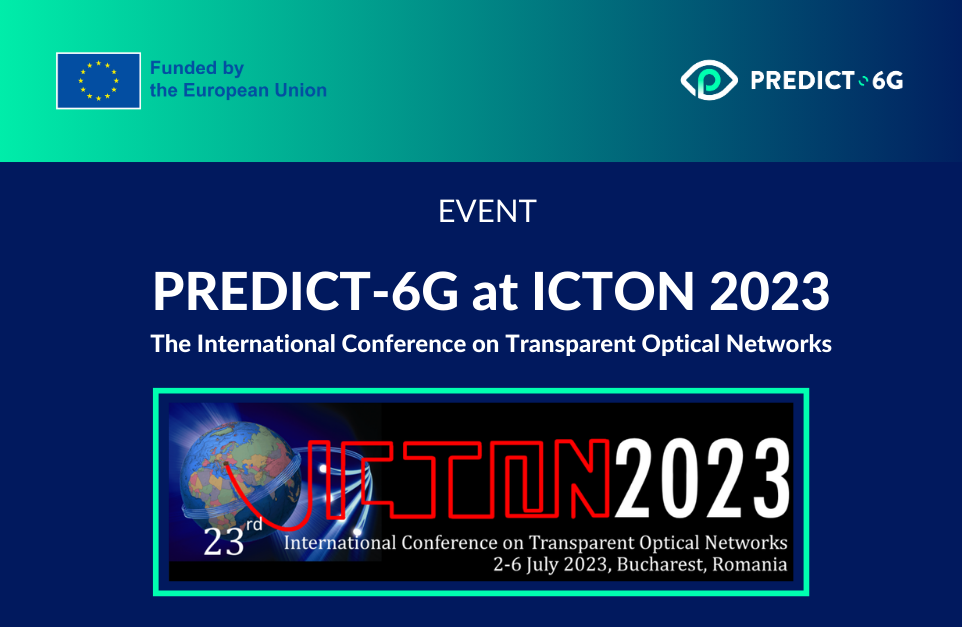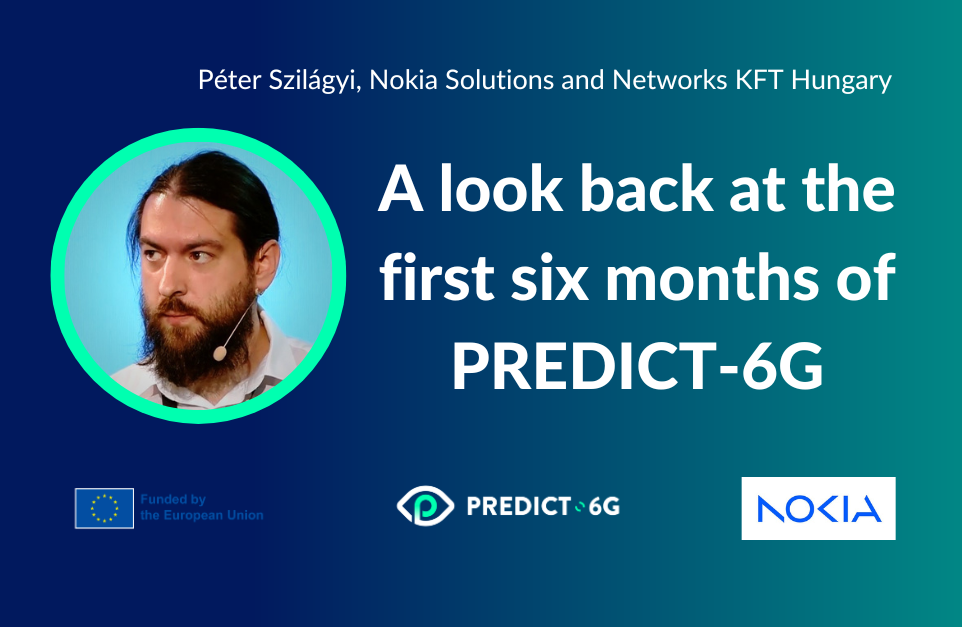Join PREDICT-6G at the MobiHoc2023
The 24th International Symposium on Theory, Algorithmic Foundations, and Protocol Design for Mobile Networks and Mobile Computing (MobiHoc 2023) will be held on the 23-26 of October 2023 in Washington DC, USA.
In this scope, DESIRE6G and PREDICT-6G will co-organise the “6G Programmable Deterministic Networking with AI” (6G-PDN) workshop, which will take place on the 23 of October. The aim is to discuss the roadmap and challenges in the technological areas of deterministic communications and deep network programmability in 6G to support future end-to- end time-critical applications, bringing together academic and industry researchers.
The programme features Kaushik Chowdhury, Professor and Vice Chair of Research at Northeastern University College of Engineering, and John Baras, Professor and Lockheed Martin Chair in Systems Engineering at the University of Maryland, as keynote speakers. Following an open call for papers, the selected authors will discuss in-depth various aspects of deterministic networks. These are organised in three sessions:
Session 1
- A hierarchical AI-based control plane solution for multi-technology deterministic networks Authors: P. Giardina, P. Szilágyi, C. Chiasserini, J. Carcel, L. Velasco, S. Spadaro, F. Agraz, S. Robitzsch, R. Rosales, V. Frascolla, R. Doostnejad, A. Calvillo, G. Bernini
- Aligning rTWT with 802.1Qbv: a Network Calculus Approach Authors: C. Barroso-Fernández, J. Martín-Pérez, C. Ayimba, A. de la Oliva
- Enabling Programmable Deterministic Communications in 6G Authors: M. Thi, S. Said, A. Roberty, F. Chbib, R. Khatoun, L. Linguaglossa
- Using RAW as Control Plane for Wireless Deterministic Networks: Challenges Ahead Authors: C. Bernardos, A. Mourad, M. Groshev, L. Contreras, M. Roselló, O. Bularca, V. Frascolla, P. Szilagyi, S. Robitzsch
Session 2
- In-Network Quality Control of IP Camera Streams Authors: C. Györgyi, K. Kecskeméti, P. Vörös, S. Laki, G. Szabó
- In-Network Security Applications with P4RROT Authors: K. Kecskeméti, C. Györgyi, P. Vörös, S. Laki
Session 3
- Towards extreme network KPIs with programmability in 6G Authors: G. Pongrácz, A. Mihály, I. Gódor, S. Laki, A. Nanos, C. Papagianni
- Failure Prediction in Software Defined Flying Ad-hoc Network Authors: D. Uomo, A. Sgambelluri, P. Castoldi, E. De Paoli, F. Paolucci, F. Cugini
Read the workshop programme here.
Register and join us!
If you want to always stay updated about our project, subscribe to our newsletter and follow us on Twitter and LinkedIn!
Deliverable 2.1 - Release 1 of PREDICT-6G MDP innovations
The PREDICT-6G deliverable 2.1 - Release 1 of PREDICT-6G MDP innovations, is now available in Zenodo for public reading.
One of the pillars of PREDICT-6G is the Deterministic Data Plane, which provides the determinism as a combination of three key concepts: Time sensitiveness, Reliability and Predictability. In this document, the PREDICT-6G consortium defines how it understands the determinism in the data plane and how it plans to enhance the determinism in different domains. It also includes the first achievements of the PREDICT-6G project and the short- and long-term plans for the WP2 -Multi-technology multi-domain Data-Plane (MDP)-.
As part of PREDICT-6G’s commitment to open science, the project uses the Zenodo repository to contain and make publicly available all the information and data related to its development.
You can read and download the Deliverable 2.1 - Release 1 of PREDICT-6G MDP innovations here.
If you want to always stay updated about our project, subscribe to our newsletter and follow us on Twitter and LinkedIn!
PREDICT-6G attends the first SNS JU Steering Board meeting
On the 5 of September 2023, the first SNS JU Steering Board (SB) meeting took place in Athens, Greece, hosted by Space Hellas. Antonio de la Oliva, coordinator of PREDICT-6G, joined the meeting alongside the other SNS project´s coordinators comprising the SB.
During this initial encounter, the SB set the foundations for its work, discussing its responsibilities as well as different suggestions to successfully fulfil its duties and respond to the needs of the community. The SB is instrumental to coordinate the research efforts and set the guidelines for advancing the SNS objectives.
If you want to always stay updated about our project, subscribe to our newsletter and follow us on Twitter and LinkedIn!
PREDICT-6G & StandICT.eu - Collaboration to Endorse Contributions to Standardisation in 6G
PISA – Italy, 01/08/2023 - StandICT.eu & PREDICT-6G announce their collaboration with the signature of the Memorandum of Understanding (MoU).
StandICT.eu fosters the participation of European experts in international ICT standardisation. To reach this goal, it has three main axes: firstly, it will fund 400+ European standardisation experts in a series of nine Open calls providing a total of almost EUR 3 million of funding. Secondly, it manages the European Observatory for ICT Standardisation (EUOS), which is an interactive online ecosystem including an up-to-date standards repository as well as working groups sharing insights about ongoing standardisation efforts across different initiatives. Thirdly, via its Academy, it trains future experts in ICT standardisation. StandICT.eu focuses on horizontal and vertical ICT fields as defined in the Rolling Plan for ICT Standardisation [1]; 5G and 6G technologies are the key focus areas.
PREDICT-6G aims to change the networking paradigm creating a deterministic 6G network: time sensitive, reliable and predictable. The creation of a secure, modular, interoperable, and extensible deterministic network and management framework will enable to automate the definition, provisioning, monitoring, fulfilment, and life-cycle management of end-to-end (E2E) deterministic services over multiple network domains, ultimately advancing the industry digitalisation.
Standardisation is essential to PREDICT-6G objectives. The project’s ambition is to participate in and contribute to different Standards Development Organisations (SDOs), thus creating a tangible impact in the standardisation community and overall, supporting Europe`s role in global standards. To achieve this, a PREDICT-6G Standardisation Advisory Committee (SAC) was established to oversee the standardisation roadmap of the project, ensuring its timely execution, to steer and advise the project on technical opportunities within relevant SDOs Working Groups (WGs), and to recommend new opportunities to the project in pre-standard and industry fora, and SDOs to increase the standardisation of PREDICT-6G’s innovations.
The MoU can consolidate even further both project’s commitments to the international standardisation in 6G.
“Standardisation is one of the cornerstones to build a future 6G network that is secure and reliable. In StandICT.eu, 5G and beyond is one of the most funded areas in our fellowship programme, supporting the standardisation efforts engaged across different standardisation bodies. Now, we warmly welcome the collaboration with PREDICT-6G, and we aim to connect the standardisation experts of the two communities to leverage the contributions of both projects in 5G/6G related standardisation”, reflects Mona Marill, Project Manager in the StandICT.eu programme.
“PREDICT-6G embraces this collaboration as a way of further increasing the standards outreach of the technical proposals of the project while helping StandICT.eu to reach more researchers in the European ecosystem”, states Antonio de la Oliva, PREDICT-6G Coordinator.
In the coming autumn, StandICT.eu will launch a technical working group that drafting a landscape of the existing 5G/ 6G standards and PREDICT-6G experts are invited to contribute. Moreover, this effort is a follow-up of the already published EUOS landscape reports that are published and shared with thousands of readers across ICT standardisation stakeholder organisations (The European Commission, MultiSakeholder Platform, International Standardization Organisations, European Standardisation Organisations, National Standardisation Bodies, Research projects etc.).
StandICT.eu 2026
Consortium: Dublin City University (IE) - Financial and Administrative Coordinator, Trust-IT Srl (IT) - Technical Coordinator, OpenForum Europe (BE), AUSTRALO (ES), European Digital SME Alliance (BE), and Fraunhofer Institute for Systems and Innovation Research ISI (DE).
For more information on StandICT.eu 2026, contact us at info@standict.eu and follow us on our social media channels: Twitter | Linkedin | YouTube
PREDICT-6G Project
Consortium: Universidad Carlos III de Madrid (ES)–Coordinator, Nokia Solutions and Networks KFT (ES), Ericsson España SA (ES), Intel Deustchland GmBH (DE), Telefónica Investigación y Desarrollo SA (ES), ATOS IT Solutions and Services Iberia SL (ES), ATOS SPAIN SA (ES), Gestamp Servicios SA (ES), Nextworks (IT), Cognitive Innovations Private Company (EL), Software Imagination & Vision SRL (RO), MTU AUSTRALO ALPHA LAB (EE), Politecnico di Torino (IT), Universitat Politecnica de Catalunya (UPC), Consiglio Nazionale delle Ricerche (IT), Universita degli Studi di Padova (IT), InterDigital Europe Ltd (UK).
For more information on PREDICT-6G, contact us at info@predict-6g.eu and follow us on our social media channels: Twitter | Linkedin
PREDICT-6G contributions to Reliable Available Wireless (RAW)
The PREDICT-6G objective of developing a determinist network architecture demands a continuous cross-fertilisation between its main elements, namely predictability, reliability and time-sensitiveness, related standards.
The IETF has recently published Carlos J. Bernardos (UC3M) contribution analysing different use cases where solutions for wireless determinism are needed. The document (RFC), part of the Reliable Available Wireless (RAW) Working Group, is available here.
Related to the activities carried out in the IETF (RAW and DetNet WGs), Carlos J. Bernardos was also invited to give a tutorial of the IETF activities in these areas in the IEEE 802 plenary that took place in July 2023 in Berlin, Germany.
The tutorial provided an overview on RAW. It particularly outlined the use cases and technologies considered by RAW and the RAW framework architecture, including Operation, Administration and Management (OAM) mechanisms.
The presentation can be found here.
If you want to always stay updated about our project, subscribe to our newsletter and follow us on Twitter and LinkedIn!
The Internet Engineering Task Force (IETF) founded in 1986, is the premiere standards development organization (SDO) for the Internet. The IETF makes voluntary standards that are often adopted by Internet users, network operators, and equipment vendors, and it thus helps shape the trajectory of the development of the Internet.
Deliverable 5.2 - Communication, Dissemination, Standardisation and Exploitation Strategy Plan, now available
The PREDICT-6G deliverable 5.2 - Communication, Dissemination, Standardisation and Exploitation Strategy Plan, is now available in Zenodo for public reading.
Communication, Dissemination, Standardisation and Exploitation are key aspects of PREDICT-6G objectives. The deliverable provides a detailed overview of PREDICT-6G’s strategy to achieve all planned outcomes, defining the goals, priorities and implementation mechanisms. To this end, the PREDICT-6G Strategy Plan sets out the objectives, tools, materials, and channels to be exploited in order to effectively spread the project’s activities, achievements and tangible results to targeted audiences, also encompassing the strategy for contributing to the standardisation and the successful market uptake of PREDICT-6G solutions.
As part of PREDICT-6G’s commitment to open science, the project uses the Zenodo repository to contain and make publicly available all the information and data related to its development.
You can read and download the Deliverable 5.2 - Communication, Dissemination, Standardisation and Exploitation Strategy Plan for free here.
If you want to always stay updated about our project, subscribe to our newsletter and follow us on Twitter and LinkedIn!
Deliverable 1.1 - Analysis of use cases and system requirements, now available
The PREDICT-6G deliverable 1.1 -Analysis of use cases and system requirements, is now available in Zenodo for public reading.
This document describes and analyses the use cases that will demonstrate and validate the technologies to be tested in the PREDICT-6G project, and establish the system requirements necessary to achieve the project's goals.
Each use case is reported, outlining the targets and Key Performance Indicators (KPIs), and analysing the technical components and systems, based on a common definition of the KPIs that will be used to analyse and evaluate the technologies used in the project and a standard methodology to compare the selected uses case. Taking this into account, a traffic characterisation and the system requirements for the project are also defined in this document, as well as, an initial explanation of the architectural and security requirements.
As part of PREDICT-6G’s commitment to open science, the project uses the Zenodo repository to contain and make publicly available all the information and data related to its development.
You can read and download the Deliverable 1.1 – Analysis of use cases and system requirements for free here.
If you want to always stay updated about our project, subscribe to our newsletter and follow us on Twitter and LinkedIn!
PREDICT-6G at ICTON 2023
The International Conference on Transparent Optical Networks (ICTON) 2023, took place from 2 to 6 July at the Central Library of University Politehnica Bucharest, Romania. The theme of this year’s Conference was focused on the applications of transparent and all-optical technologies in telecommunications, computing and novel applications.
Conference topics included, among others, digital all-optical networks, next generation networking, network reliability and availability, wireless and optical networking, and 5G to 6G communications. All subjects discussed during the Conference are of great interest for the development of PREDICT-6G, which participated in ICTON 2023 with three sessions that have subsequently resulted in the publication of conference papers.
On July 3, Dr. Luis Velasco and Marc Ruiz, members of the PREDICT-6G consortium on behalf of the Universitat Politècnica de Catalunya (UPC), chaired the “8th Workshop on Beyond-5G Network Operation (B5GNeO)”. During the workshop, Jaume Comellas and Davide Careglio, also members of the UPC, presented two papers.
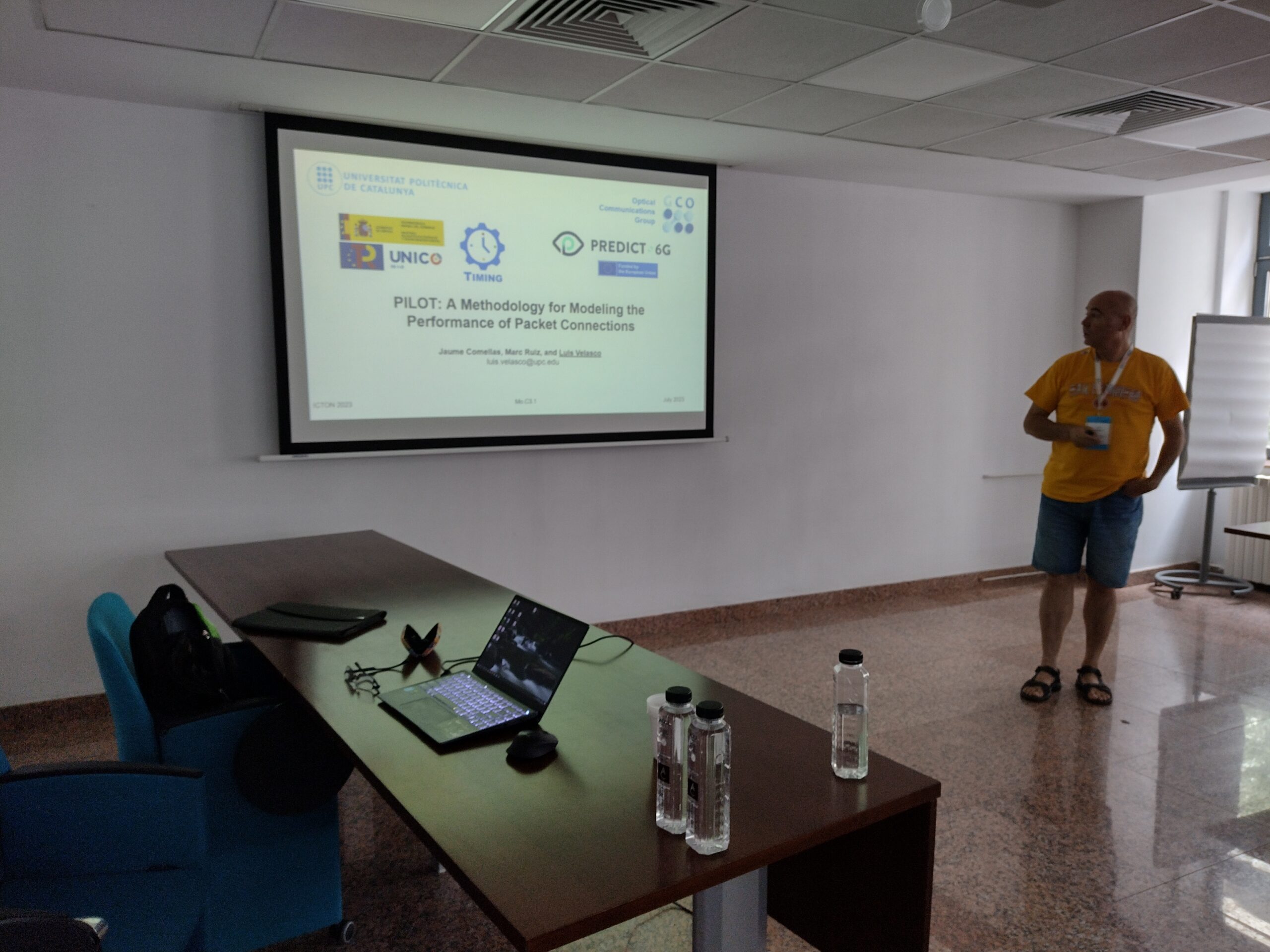
Jaume Comellas presented the paper “PILOT: A methodology for modeling the performance of packet connections”. This paper presents the PILOT methodology for modeling the performance of packet connections during commissioning testing in terms of throughput, delay and jitter. PILOT runs in a sandbox domain and constructs a scenario where an efficient traffic flow simulation environment, based on the CURSA-SQ model, is used to generate large amounts of data for Machine Learning model training and validation. The simulation scenario is tuned using real measurements of the connection obtained from a set of active probes. You can read the full paper here.
Davide Careglio presented the paper “Disaggregated delay modeling in multidomain networks”. In this paper, the team proposes a collaborative environment, where each domain models intra-domain delay components of inter-domain paths and shares those models with a broker system providing the E2E connectivity services. The broker, in turn, models the delay of inter-domain links based on E2E monitoring and the received intra-domain models. You can read the full paper here.
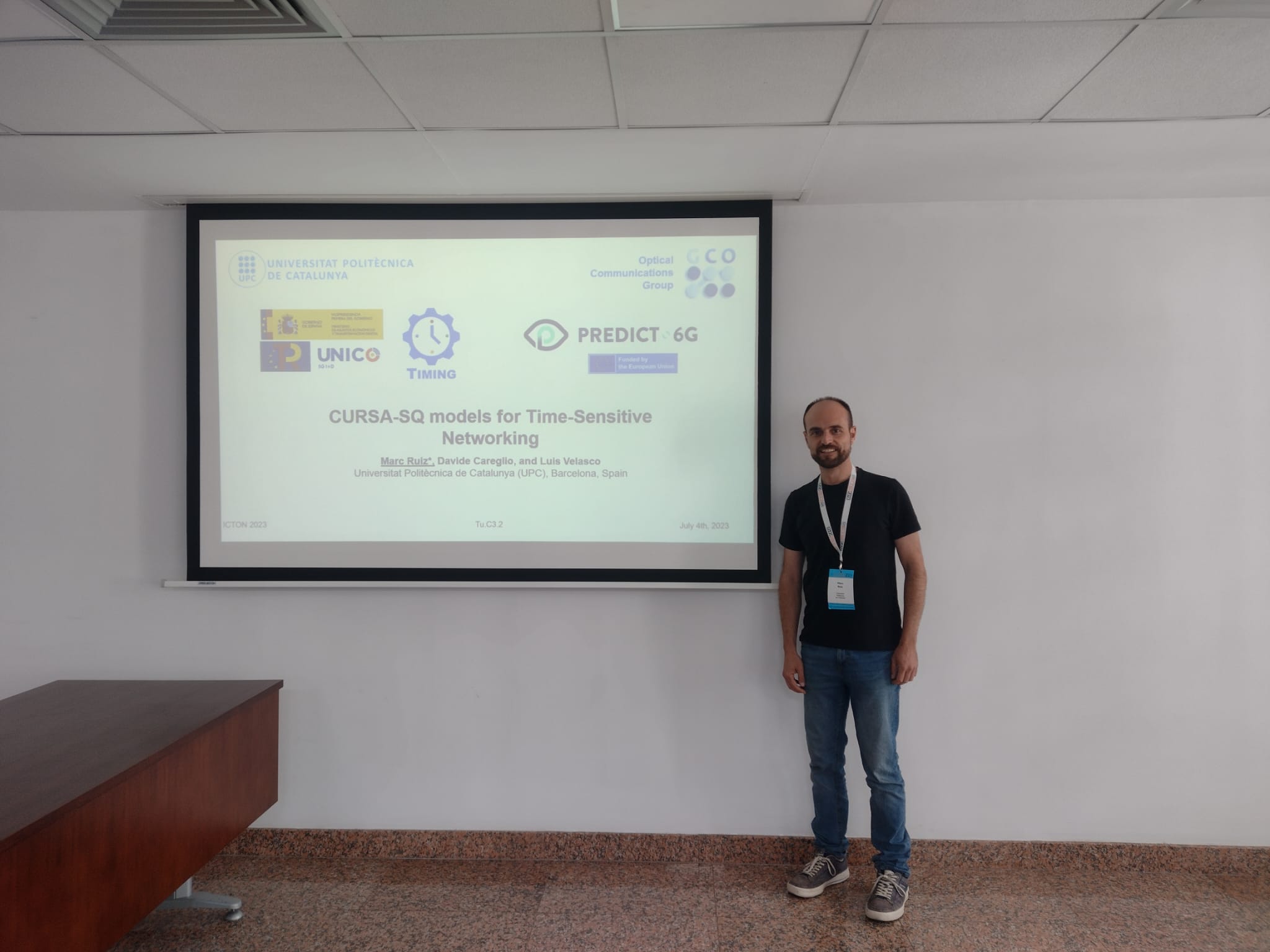
The following day, July 4, also as part of the B5GNeO workshop invited presentations, Marc Ruiz from the UPC presented the paper “CURSA-SQ models for time-sensitive networking”. This paper focuses on analysing the impact of conveying time-sensitive traffic in operators’ networks when such traffic is mixed with best-effort traffic. In particular, extensions to a continuous G/G/1/k queue model are proposed to evaluate two different Ethernet technologies, synchronous and asynchronous, supporting time-sensitive flows in terms of their influence on the performance of best-effort traffic. You can read the full paper here.
If you want to always stay updated about our project, subscribe to our newsletter and follow us on Twitter and LinkedIn!
ICTON is organised by The National Institute of Telecommunications, former Department of Transmission and Optical Technologies in Warsaw, together with the University Politehnica Bucharest and the IEEE Photonics Society Poland Chapter.
PREDICT-6G at the IEEE 802 Plenary Tutorial
On the 10th of July 2023, Carlos J. Bernardos (UC3M) and János Farkas (ERICSSON) will participate in the IEEE 802 Plenary Tutorial in Berlin, Germany, with a session about IETF Reliable Available Wireless (RAW).
The tutorial provides an overview on RAW. It particularly outlines the use cases and technologies considered by RAW and the RAW framework architecture, including Operation, Administration and Management (OAM) mechanisms.
You can follow the event online here.
The work of Carlos J. Bernardos in this tutorial has been partially supported by the Horizon Europe PREDICT-6G (Grant 101095890) project.
We very much welcome your participation!
The IETF Deterministic (DetNet) Working Group aims to standardise technologies to provide deterministic Layer 3 communications for various use cases, including professional audio and video, electrical utilities or wireless, whereas the RAW Working Group was established to extend the DetNet architecture and solutions to wireless networks.
A look back at the first six months of PREDICT-6G
By Péter Szilágyi, PREDICT-6G Technical Manager
It’s been six months since PREDICT-6G kicked off, and the wheels – prepared carefully during the planning – were set in motion. Within that time, we have built a well functioning team, gained remarkable momentum, and started to fill our pipeline of technology and innovation. This article reflects on the key achievements so far, the status of the project, and the next steps – from a technical perspective.
What we have achieved
The first period of the project focused on setting the landscape, collecting and structuring ideas, discussing and documenting our approach to multi-domain deterministic networks and services, and roadmapping the underlying technical work. We have established solid understanding of the use cases (such as smart manufacturing and industrial critical communication) requiring deterministic services across multiple domains. For each use case, we studied the end-to-end communication requirements, the capabilities of the devices, the types and roles of the actors and their anticipated demand and traffic mix. The findings were consolidated and generalized to produce system level and service level KPIs and requirements, serving as design principles and capabilities towards the PREDICT-6G system. Based on the requirements, we have already created the first architecture blueprint of the project, including both the multi-technology multi-domain data plane and the AI-driven inter-domain control plane, as well as the means of their interworking. On the groundwork side, we have established a roadmap for the two Open Labs where the PREDICT-6G technology and innovations will be implemented and demonstrated through the selected use cases. Finally, we have created two important pieces of deliverables: our Data Management Plan (DMP), which defines the standards for preparing, publishing and maintaining open access to all types of data, including documentation, measurements and source code to be produced by PREDICT-6G; and our first version of the communication, dissemination, standardization and exploitation strategy plan.
Where we are now
We are in a busy schedule paved with deliverables on all of our research directions. We are just releasing D1.1, our first technical report summarizing the use cases, requirements and initial architecture of the PREDICT-6G. I recommend reading this document for those who would like to get familiar with the project’s technical line of thought and innovation areas, as these aspects already started to manifest in this work. In parallel to finishing D1.1 under WP1, we are cooperating very closely between two of our other technical work packages: WP2, which is defining the deterministic technologies for data planes and cross-domain data plane integration; and WP3, which is defining the automation framework on the control and management plane to self-orchestrate and autonomously assure end-to-end deterministic services. These two WPs are expected to be the busiest ones in the next four months, as they work together to co-create two sets of dependent technologies. On the one hand, in WP2, to expose programmable data plane capabilities from within specific network technologies such as 3GPP, IETF DetNet/RAW, and Wi-Fi; and on the other hand, in WP3, to utilize those exposed capabilities to autonomously fulfil and assure the end-to-end services. Additionally, WP4 takes off in July, to start working on system integration aspects that would bring all PREDICT-6G technical components into the same autonomous framework.
Looking ahead
Summer will be hot for PREDICT-6G, and not only for the season. We will produce our next two deliverables, which are going to consolidate part of the effort we are currently putting into the cross-WP2-WP3 work. To be released at the end of August, D2.1 will descend deeper into the data plane technologies, whereas one month later, D3.1 will report the first results on the control and management plane technologies, already leveraging the capabilities of our data plane. These deliverables will maintain close coherence and context with each other and with D1.1, so that interested readers can easily navigate the breadths and depths of the PREDICT-6G technology. These two upcoming deliverables will also set up the forward path to their second versions, which are both due near the end of this year, going even deeper into their subjects. By that time, PREDICT-6G will have created and released substantial technical capital that will be a foundation for starting lab work in 2024.
Summary
Nowadays are intense yet interesting times in PREDICT-6G. Our momentum accelerates, the frontier of the research broadens, and the number of ongoing activities increase. While this means that work is split up and task forces are focusing on specific areas of PREDICT-6G to maintain efficiency and productivity, we take special care to leverage cross-WP and cross-partner expertise as we drive along our micro-objectives. All in all, we have an excellent team working together on a research project with a great aim – and that is all that’s needed.
If you want to always stay updated about our project, subscribe to our newsletter and follow us on Twitter and LinkedIn!


